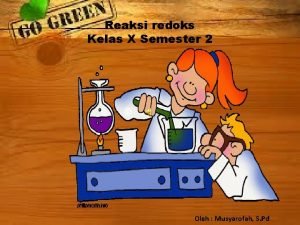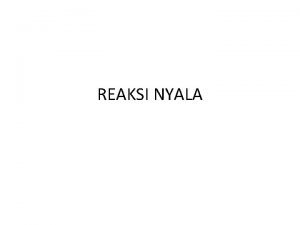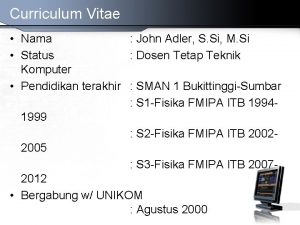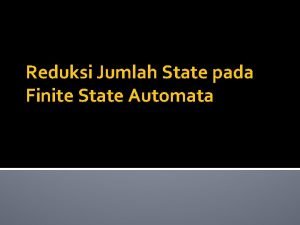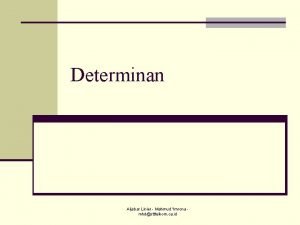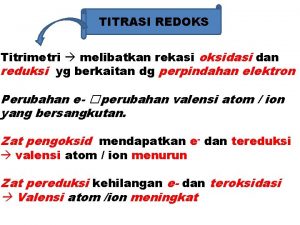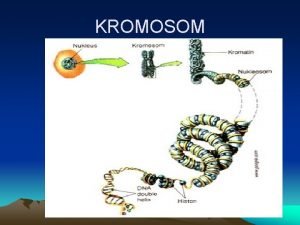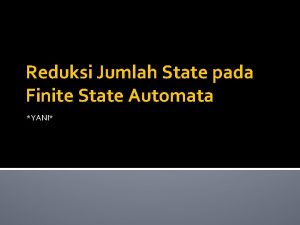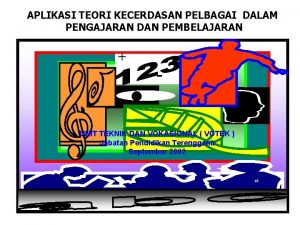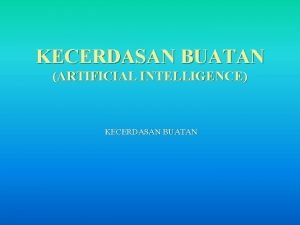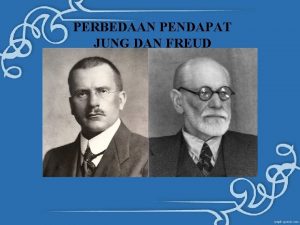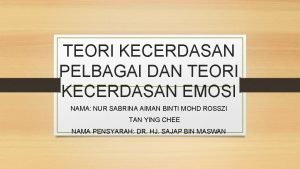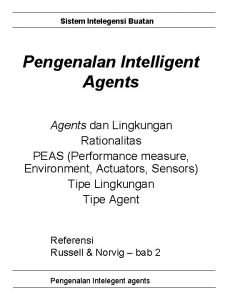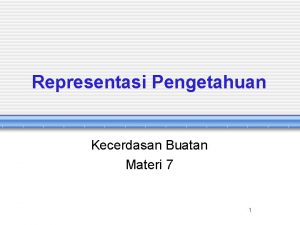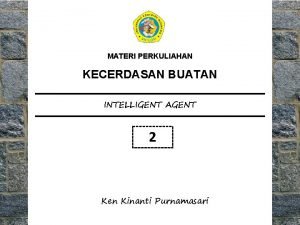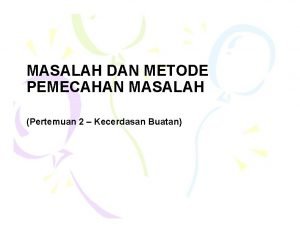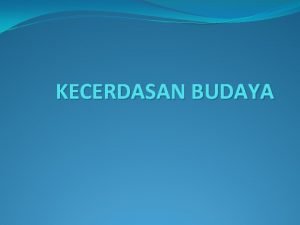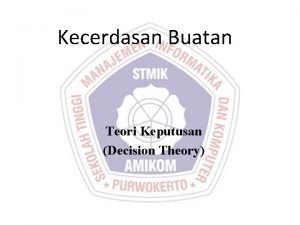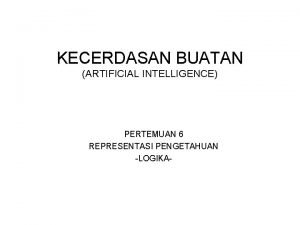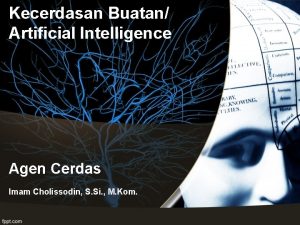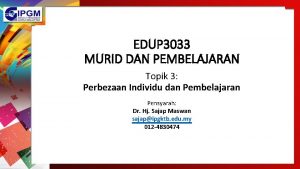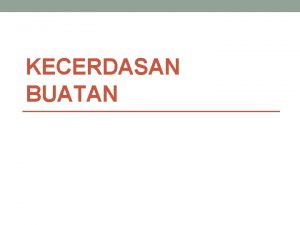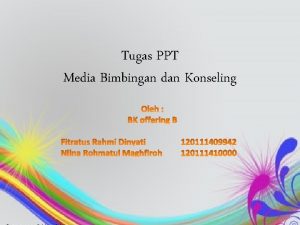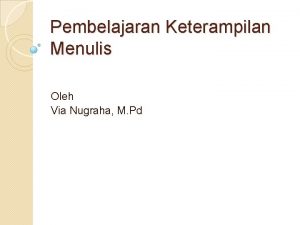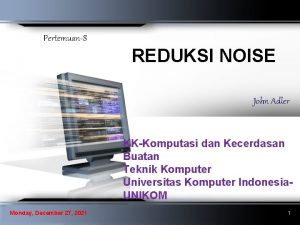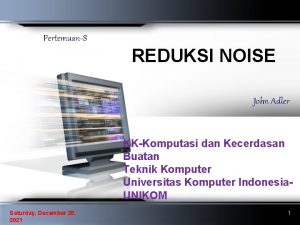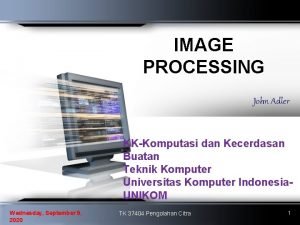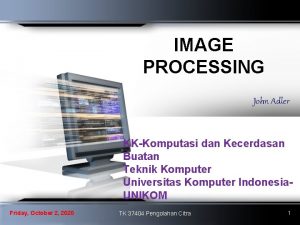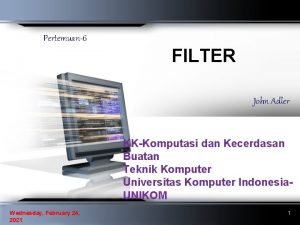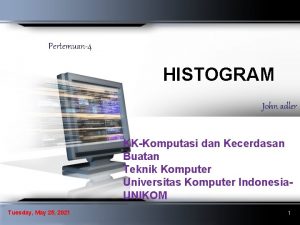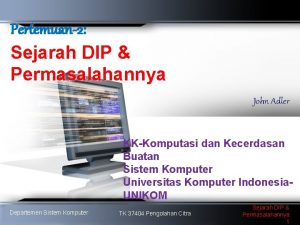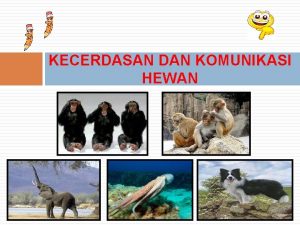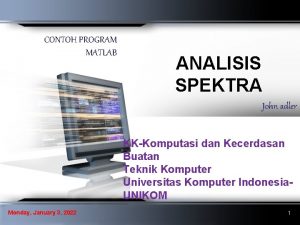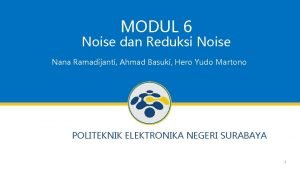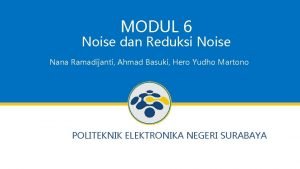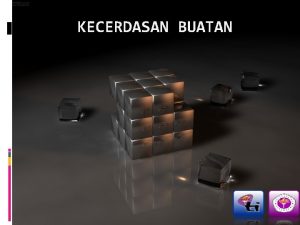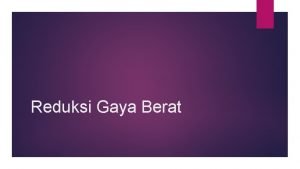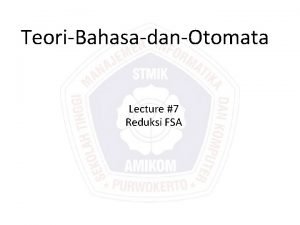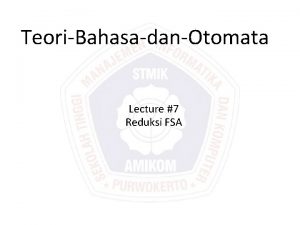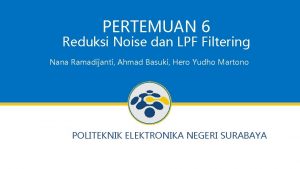Pertemuan8 REDUKSI NOISE John Adler KKKomputasi dan Kecerdasan































- Slides: 31

Pertemuan-8 REDUKSI NOISE John Adler KK-Komputasi dan Kecerdasan Buatan Teknik Komputer Universitas Komputer Indonesia. UNIKOM Sunday, December 19, 2021 1

EECECS 253 Image Processing Lecture Notes on Mathematical Morphology: The Lecture Notes Median Filter Richard Alan Peters II Department of Electrical Engineering and Computer Science Fall Semester 2011 . 1. %. {. . . {. {. . This work is licensed under the Creative Commons Attribution-Noncommercial 2. 5 License. To view a copy of this license, visit http: //creativecommons. org/licenses/by-nc/2. 5/ or send a letter to Creative Commons, 543 Howard Street, 5 th Floor, San Francisco, California, 94105, USA.

Pratt & Whitney Rocketdyne J-2 rocket engines on Apollo 18’s Saturn V second stage. Inverse of Masked Fourier Transform original image 15 November 2011 noise reduced image 3 1999 -2011 by 3 II Richard Alan Peters

Notch filter reduction of periodic noise 1. 2. 3. 4. 5. 6. 7. 8. 9. Take the FFT of the input image. F = fft 2(I). Display the log power spectrum of the fftshift-ed F. Find the locations, xi, of the spikes that correspond to the periodic distortion. Create a 1 -band image, M, of class double the same size as I. Set all M’s pixels to 1. 0. Let N(xi) be a neighborhood of xi with area sufficient to cover the spike at xi. For each xi do: for each yj ϵ N(xi), set M(yj) = 0. Blur M with a Gaussian whose is smaller than ½ the radius of N(xi). Take the ifftshift of M. 10. For each band, k, of the image let Gk = Fk. *M. 11. Then the noise-reduced image is: J = real(ifft 2(G)). 15 November 2011 4 1999 -2011 by 4 II Richard Alan Peters

How to determine the frequency and period of a point in the log power spectrum of an image (ex. ): (0, 0) C/2 + 1 C/2 - 1 R/2 - 1 R C/2 + 1 R/2 + 1 C original image 15 November 2011 quadrant partition of PS 5 loc of (0, 0) in fftshift(PS) 1999 -2011 by 5 II Richard Alan Peters

How to determine the frequency and period of a point in the log power spectrum of an image (ex. ): (0, 0) 170 169 170 239 480 241 339 original image 15 November 2011 quadrant partition of PS 6 loc of (0, 0) in fftshift(PS) 1999 -2011 by 6 II Richard Alan Peters

How to determine the frequency and period of a point in the log power spectrum of an image: c r 1 v r 2 -v -u R/2 + 1 c 1 2 u C/2 + 1 15 November 2011 7 1999 -2011 by 7 II Richard Alan Peters

How to determine the frequency and period of a point in the log power spectrum of an image: v -v -u u 15 November 2011 8 1999 -2011 by 8 II Richard Alan Peters

Points on the Fourier Plane (of a Digital Image) In the Fourier transform of an R×C digital image the wavelengths, u and v represent a fraction of the R and C values. That is, -v direction of a digital image The wavefront direction is given by The frequencies represent fractions of R & C, (0, 0) 15 November 2011 9 u direction -θ direction and the wavelength is 1999 -2011 by 9 II Richard Alan Peters

How to determine the frequency plane location of a sinusoid: c 257 512 r -64 -32 257 32 r 512 64 Orientation, -q, is measured CCW from c. cosine grating = 32 2, q = - /4 r = 64 = 512/v, c = 64 = 512/v 15 November 2011 1999 -2011 by Richard Alan Peters II 10

How to determine the frequency plane location of a sinusoid: r =1 u=-256 c =1 v=-256 c =512 v=255 -8 v 8 (0, 0) (257, 257) v u= ± 512/64 v= ± 512/64 u u cosine grating = 8 2, orientation = 3 /4 u = ± 8, v = ± 8 r =512 u=255 15 November 2011 11 1999 -2011 by 11 II Richard Alan Peters

Sinusoidal grating image with an even number or rows and an odd number of columns. c r -23 r c= 40 512 767 sine grating = 20, orient. = 5 /6 r= 20/cos(5 /6) -23 , c= 20/sin(5 /6) = 40 15 November 2011 12 1999 -2011 by 12 II Richard Alan Peters

FT of Sinusoidal Grating Image -22 -19 19 (0, 0) 22 v 752 937 sine grating = 20, orient. = 5 /6 u = ± 512/ r ± 22 , v = ± 767/ c ± 19 u 15 November 2011 13 1999 -2011 by 13 II Richard Alan Peters

Processing Scanned Press-Printed Images 4 -color printing: 1. 2. 3. 4. A photograph or other color image is separated into four intensity band images: cyan, magenta, yellow, and black. Each of these is multiplied by a halftone screen 1 – a dot mask with a unique orientation. Each of the resulting four images shows a pattern of dots whose individual sizes indicate the amount of ink to be applied at each point. The four images are printed, one atop the other, in the corresponding color. 1 Merriam-Webster Dictionary: half·tone 2 (1): a photoengraving made from an image photographed through a screen and then etched so that the details of the image are reproduced in dots. 15 November 2011 14 1999 -2011 by 14 II Richard Alan Peters

frequency space Halftone Screen (45°) is the pointwise product of 2 sinusoidal gratings with perpendicular orientations. 15 November 2011 15 1999 -2011 by 15 II Richard Alan Peters

frequency space Halftone Screens (90°) The orientation of the screen is the average of the grating orientations. 15 November 2011 16 1999 -2011 by 16 II Richard Alan Peters

Standard Halftone Screen Angles Cyan: Yellow: Magenta: Black: 105° 90° 75° 45° Image from Adobe Photoshop CS 2 documentation. 15 November 2011 17 1999 -2011 by 17 II Richard Alan Peters

Each band has 2 perpendicular sinusoids + a DC component… CMYK Standard Halftone Screens Power Spectra 15 November 2011 18 1999 -2011 by 18 II Richard Alan Peters

… which creates rectangular grids at 4 different angles. CMYK Standard Halftone Screens cyan magenta 105° 75° yellow black 90° 45° space domain images 15 November 2011 19 1999 -2011 by 19 II Richard Alan Peters

When the 4 are summed, the result is a “rosette” image. CMYK Standard Halftone Screens cyan magenta 105° 75° yellow black 90° 45° space domain images 15 November 2011 20 1999 -2011 by 20 II Richard Alan Peters

To print an image, it is separated into 4 color bands … Example: Color Separation / Halftoning That is, an intensity image is created for each of the four color bands. 15 November 2011 21 1999 -2011 by 21 II Richard Alan Peters

… each of which is multiplied by a corresponding screen. Color Separation / Halftoning Each intensity image is multiplied by a corresponding screen, then Cyan Magenta Yellow Black each screened image is printed in its own color on the same page. 15 November 2011 22 1999 -2011 by 22 II Richard Alan Peters

To print an image, it is separated into 4 color bands … Example: Color Separation / Halftoning Here the bands tinted in their corresponding colors. 15 November 2011 23 1999 -2011 by 23 II Richard Alan Peters

… each of which is multiplied by a corresponding screen … Example: Color Separation / Halftoning Here the screens tinted in their corresponding colors. 15 November 2011 24 1999 -2011 by 24 II Richard Alan Peters

…to get dot patterns for printing. The 4 are printed over each other to get the final result. Example: Color Separation / Halftoning 15 November 2011 25 1999 -2011 by 25 II Richard Alan Peters

Halftone Dots Image scanned (600 dpi) from a magazine 15 November 2011 Detail: Circular patterns, the rosettes, are the result of the halftone dots. 26 1999 -2011 by 26 II Richard Alan Peters

Filtering Out Halftone Dot Distortion original 15 November 2011 log power spectrum 27 1999 -2011 by 27 II Richard Alan Peters

Filtering Out Halftone Dot Distortion Each pair of peaks corresponds to a sinusoidal sub-pattern in the HTD pattern. original 15 November 2011 log power spectrum 28 1999 -2011 by 28 II Richard Alan Peters

Blurring with a Gaussian (σ = 1) blurred image σ=1 15 November 2011 log power spectrum σ=1 29 1999 -2011 by 29 II Richard Alan Peters

Referensi • Erkki Rämö, Digital Media, “Image Processing”, Principal Lecturer, Metropolia University of Applied Sciences. • Richard Alan Peters II, EECE/CS 253 Image Processing, Lecture Note : Reduction of Uncorrelated Noise, Department of Electrical Engineering and Computer Science, Fall Semester 2011, Vanderbilt University School of Engineering Sunday, December 19, 2021 30

TERIMA KASIH Sunday, December 19, 2021 31
 Reaksi oksidasi
Reaksi oksidasi Elektron valensi fluor
Elektron valensi fluor Nyala api reduksi dan oksidasi
Nyala api reduksi dan oksidasi Quantization noise in pcm
Quantization noise in pcm Adler cw
Adler cw Reduksi state dfa
Reduksi state dfa Lambang determinan matriks
Lambang determinan matriks Titrasi redoks
Titrasi redoks Reduksi kromosom
Reduksi kromosom Reduksi fsa
Reduksi fsa Metode pencarian dalam kecerdasan buatan
Metode pencarian dalam kecerdasan buatan Kecerdasan pelbagai dalam pengajaran dan pembelajaran
Kecerdasan pelbagai dalam pengajaran dan pembelajaran Pengertian kecerdasan menurut winston dan pendergast, 1994
Pengertian kecerdasan menurut winston dan pendergast, 1994 Teori jung psikologi kepribadian
Teori jung psikologi kepribadian Kinestetik kerjaya
Kinestetik kerjaya Contoh peas
Contoh peas Contoh script kecerdasan buatan
Contoh script kecerdasan buatan Contoh blue print psikologi
Contoh blue print psikologi Contoh peas kecerdasan buatan
Contoh peas kecerdasan buatan Contoh pemecahan masalah dalam kecerdasan buatan
Contoh pemecahan masalah dalam kecerdasan buatan Kecerdasan budaya
Kecerdasan budaya Regret matrix
Regret matrix Propotional logic dapat digunakan untuk
Propotional logic dapat digunakan untuk Jenis agen cerdas
Jenis agen cerdas Contoh penerapan logika fuzzy
Contoh penerapan logika fuzzy Fokus kecerdasan pelbagai
Fokus kecerdasan pelbagai Uas kecerdasan buatan
Uas kecerdasan buatan Silabus kecerdasan buatan
Silabus kecerdasan buatan Kecerdasan majemuk ppt
Kecerdasan majemuk ppt Menulis menyumbang kecerdasan
Menulis menyumbang kecerdasan Artificial intelligence leadership
Artificial intelligence leadership Pengertian kecerdasan visual spasial
Pengertian kecerdasan visual spasial
